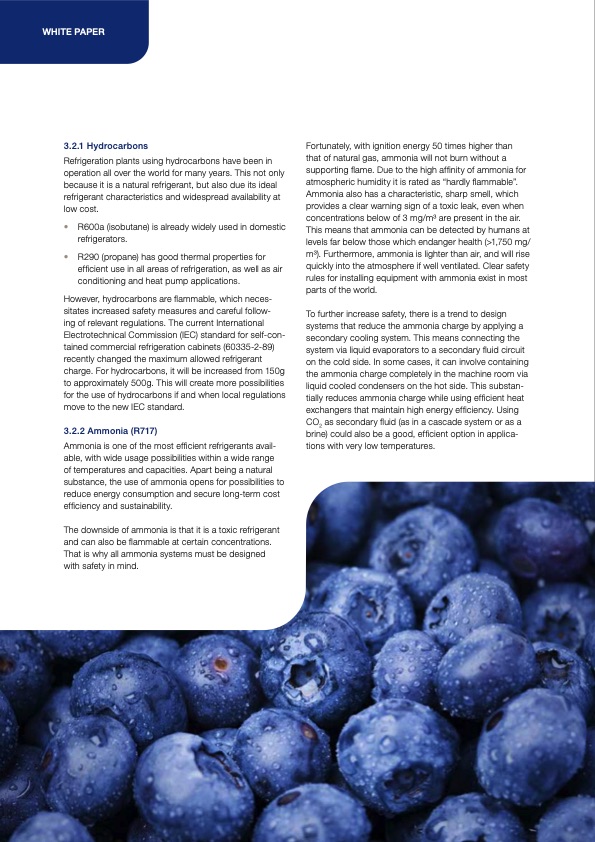
PDF Publication Title:
Text from PDF Page: 008
WHITE PAPER 3.2.1 Hydrocarbons Refrigeration plants using hydrocarbons have been in operation all over the world for many years. This not only because it is a natural refrigerant, but also due its ideal refrigerant characteristics and widespread availability at low cost. • R600a (isobutane) is already widely used in domestic refrigerators. • R290 (propane) has good thermal properties for efficient use in all areas of refrigeration, as well as air conditioning and heat pump applications. However, hydrocarbons are flammable, which neces- sitates increased safety measures and careful follow- ing of relevant regulations. The current International Electrotechnical Commission (IEC) standard for self-con- tained commercial refrigeration cabinets (60335-2-89) recently changed the maximum allowed refrigerant charge. For hydrocarbons, it will be increased from 150g to approximately 500g. This will create more possibilities for the use of hydrocarbons if and when local regulations move to the new IEC standard. 3.2.2 Ammonia (R717) Ammonia is one of the most efficient refrigerants avail- able, with wide usage possibilities within a wide range of temperatures and capacities. Apart being a natural substance, the use of ammonia opens for possibilities to reduce energy consumption and secure long-term cost efficiency and sustainability. The downside of ammonia is that it is a toxic refrigerant and can also be flammable at certain concentrations. That is why all ammonia systems must be designed with safety in mind. Fortunately, with ignition energy 50 times higher than that of natural gas, ammonia will not burn without a supporting flame. Due to the high affinity of ammonia for atmospheric humidity it is rated as “hardly flammable”. Ammonia also has a characteristic, sharp smell, which provides a clear warning sign of a toxic leak, even when concentrations below of 3 mg/m3 are present in the air. This means that ammonia can be detected by humans at levels far below those which endanger health (>1,750 mg/ m3). Furthermore, ammonia is lighter than air, and will rise quickly into the atmosphere if well ventilated. Clear safety rules for installing equipment with ammonia exist in most parts of the world. To further increase safety, there is a trend to design systems that reduce the ammonia charge by applying a secondary cooling system. This means connecting the system via liquid evaporators to a secondary fluid circuit on the cold side. In some cases, it can involve containing the ammonia charge completely in the machine room via liquid cooled condensers on the hot side. This substan- tially reduces ammonia charge while using efficient heat exchangers that maintain high energy efficiency. Using CO2 as secondary fluid (as in a cascade system or as a brine) could also be a good, efficient option in applica- tions with very low temperatures. 8PDF Image | guide for selecting and accommodating refrigerants

PDF Search Title:
guide for selecting and accommodating refrigerantsOriginal File Name Searched:
refrigerants-market_white_paper_en.pdfDIY PDF Search: Google It | Yahoo | Bing
CO2 Organic Rankine Cycle Experimenter Platform The supercritical CO2 phase change system is both a heat pump and organic rankine cycle which can be used for those purposes and as a supercritical extractor for advanced subcritical and supercritical extraction technology. Uses include producing nanoparticles, precious metal CO2 extraction, lithium battery recycling, and other applications... More Info
Heat Pumps CO2 ORC Heat Pump System Platform More Info
| CONTACT TEL: 608-238-6001 Email: greg@infinityturbine.com | RSS | AMP |